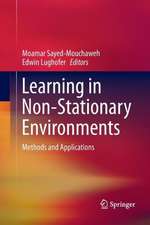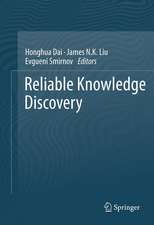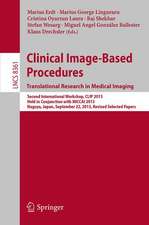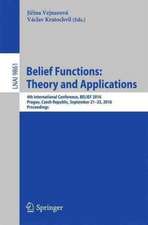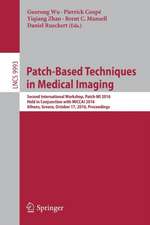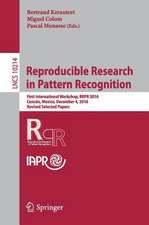Statistical and Neural Classifiers: An Integrated Approach to Design: Advances in Computer Vision and Pattern Recognition
Autor Sarunas Raudysen Limba Engleză Paperback – 9 apr 2014
| Toate formatele și edițiile | Preț | Express |
|---|---|---|
| Paperback (1) | 703.71 lei 6-8 săpt. | |
| SPRINGER LONDON – 9 apr 2014 | 703.71 lei 6-8 săpt. | |
| Hardback (1) | 994.58 lei 6-8 săpt. | |
| SPRINGER LONDON – 29 ian 2001 | 994.58 lei 6-8 săpt. |
Din seria Advances in Computer Vision and Pattern Recognition
- 20%
 Preț: 998.36 lei
Preț: 998.36 lei - 20%
 Preț: 409.80 lei
Preț: 409.80 lei - 20%
 Preț: 654.70 lei
Preț: 654.70 lei - 20%
 Preț: 775.30 lei
Preț: 775.30 lei - 20%
 Preț: 867.15 lei
Preț: 867.15 lei - 20%
 Preț: 241.87 lei
Preț: 241.87 lei - 20%
 Preț: 659.83 lei
Preț: 659.83 lei - 20%
 Preț: 1084.17 lei
Preț: 1084.17 lei - 20%
 Preț: 328.60 lei
Preț: 328.60 lei - 20%
 Preț: 650.08 lei
Preț: 650.08 lei - 20%
 Preț: 644.66 lei
Preț: 644.66 lei - 20%
 Preț: 652.54 lei
Preț: 652.54 lei - 20%
 Preț: 646.80 lei
Preț: 646.80 lei - 20%
 Preț: 993.60 lei
Preț: 993.60 lei - 20%
 Preț: 1174.92 lei
Preț: 1174.92 lei - 20%
 Preț: 646.80 lei
Preț: 646.80 lei - 20%
 Preț: 672.36 lei
Preț: 672.36 lei - 20%
 Preț: 1166.52 lei
Preț: 1166.52 lei - 20%
 Preț: 920.33 lei
Preț: 920.33 lei - 20%
 Preț: 825.78 lei
Preț: 825.78 lei - 20%
 Preț: 666.58 lei
Preț: 666.58 lei - 18%
 Preț: 953.65 lei
Preț: 953.65 lei - 20%
 Preț: 999.35 lei
Preț: 999.35 lei - 20%
 Preț: 655.02 lei
Preț: 655.02 lei - 20%
 Preț: 595.16 lei
Preț: 595.16 lei - 20%
 Preț: 647.61 lei
Preț: 647.61 lei - 20%
 Preț: 658.33 lei
Preț: 658.33 lei - 20%
 Preț: 1649.61 lei
Preț: 1649.61 lei - 20%
 Preț: 991.46 lei
Preț: 991.46 lei - 20%
 Preț: 994.08 lei
Preț: 994.08 lei - 20%
 Preț: 1062.57 lei
Preț: 1062.57 lei - 20%
 Preț: 985.16 lei
Preț: 985.16 lei - 20%
 Preț: 640.35 lei
Preț: 640.35 lei - 20%
 Preț: 656.03 lei
Preț: 656.03 lei - 18%
 Preț: 950.52 lei
Preț: 950.52 lei - 20%
 Preț: 652.41 lei
Preț: 652.41 lei - 20%
 Preț: 644.81 lei
Preț: 644.81 lei - 20%
 Preț: 996.40 lei
Preț: 996.40 lei
Preț: 703.71 lei
Preț vechi: 879.64 lei
-20% Nou
Puncte Express: 1056
Preț estimativ în valută:
134.66€ • 143.99$ • 112.27£
134.66€ • 143.99$ • 112.27£
Carte tipărită la comandă
Livrare economică 18 aprilie-02 mai
Preluare comenzi: 021 569.72.76
Specificații
ISBN-13: 9781447110712
ISBN-10: 1447110714
Pagini: 324
Ilustrații: XXIII, 295 p. 40 illus.
Dimensiuni: 155 x 235 x 17 mm
Greutate: 0.45 kg
Ediția:2001
Editura: SPRINGER LONDON
Colecția Springer
Seria Advances in Computer Vision and Pattern Recognition
Locul publicării:London, United Kingdom
ISBN-10: 1447110714
Pagini: 324
Ilustrații: XXIII, 295 p. 40 illus.
Dimensiuni: 155 x 235 x 17 mm
Greutate: 0.45 kg
Ediția:2001
Editura: SPRINGER LONDON
Colecția Springer
Seria Advances in Computer Vision and Pattern Recognition
Locul publicării:London, United Kingdom
Public țintă
ResearchCuprins
1. Quick Overview.- 1.1 The Classifier Design Problem.- 1.2 Single Layer and Multilayer Perceptrons.- 1.3 The SLP as the Euclidean Distance and the Fisher Linear Classifiers.- 1.4 The Generalisation Error of the EDC and the Fisher DF.- 1.5 Optimal Complexity — The Scissors Effect.- 1.6 Overtraining in Neural Networks.- 1.7 Bibliographical and Historical Remarks.- 2. Taxonomy of Pattern Classification Algorithms.- 2.1 Principles of Statistical Decision Theory.- 2.2 Four Parametric Statistical Classifiers.- 2.3 Structures of the Covariance Matrices.- 2.4 The Bayes Predictive Approach to Design Optimal Classification Rules.- 2.5. Modifications of the Standard Linear and Quadratic DF.- 2.6 Nonparametric Local Statistical Classifiers.- 2.7 Minimum Empirical Error and Maximal Margin Linear Classifiers.- 2.8 Piecewise-Linear Classifiers.- 2.9 Classifiers for Categorical Data.- 2.10 Bibliographical and Historical Remarks.- 3. Performance and the Generalisation Error.- 3.1 Bayes, Conditional, Expected, and Asymptotic Probabilities of Misclassification.- 3.2 Generalisation Error of the Euclidean Distance Classifier.- 3.3 Most Favourable and Least Favourable Distributions of the Data.- 3.4 Generalisation Errors for Modifications of the Standard Linear Classifier.- 3.5 Common Parameters in Different Competing Pattern Classes.- 3.6 Minimum Empirical Error and Maximal Margin Classifiers.- 3.7 Parzen Window Classifier.- 3.8 Multinomial Classifier.- 3.9 Bibliographical and Historical Remarks.- 4. Neural Network Classifiers.- 4.1 Training Dynamics of the Single Layer Perceptron.- 4.2 Non-linear Decision Boundaries.- 4.3 Training Peculiarities of the Perceptrons.- 4.4 Generalisation of the Perceptrons.- 4.5 Overtraining and Initialisation.- 4.6 Tools to Control Complexity.- 4.7 TheCo-Operation of the Neural Networks.- 4.8 Bibliographical and Historical Remarks.- 5. Integration of Statistical and Neural Approaches.- 5.1 Statistical Methods or Neural Nets?.- 5.2 Positive and Negative Attributes of Statistical Pattern Recognition.- 5.3 Positive and Negative Attributes of Artificial Neural Networks.- 5.4 Merging Statistical Classifiers and Neural Networks.- 5.5 Data Transformations for the Integrated Approach.- 5.6 The Statistical Approach in Multilayer Feed-forward Networks.- 5.7 Concluding and Bibliographical Remarks.- 6. Model Selection.- 6.1 Classification Errors and their Estimation Methods.- 6.2 Simplified Performance Measures.- 6.3 Accuracy of Performance Estimates.- 6.4 Feature Ranking and the Optimal Number of Feature.- 6.5 The Accuracy of the Model Selection.- 6.6 Additional Bibliographical Remarks.- Appendices.- A.1 Elements of Matrix Algebra.- A.2 The First Order Tree Type Dependence Model.- A.3 Temporal Dependence Models.- A.4 Pikelis Algorithm for Evaluating Means and Variances of the True, Apparent and Ideal Errors in Model Selection.- A.5 Matlab Codes (the Non-Linear SLP Training, the First Order Tree Dependence Model, and Data Whitening Transformation).- References.
Caracteristici
Covers the state of the art in this important area Shows the reader how neural network classifiers actually work


